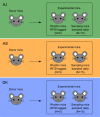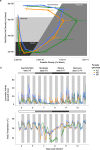Host circadian rhythms are disrupted during malaria infection in parasite genotype-specific manners
- PMID: 31358780
- PMCID: PMC6662749
- DOI: 10.1038/s41598-019-47191-8
Host circadian rhythms are disrupted during malaria infection in parasite genotype-specific manners
Abstract
Infection can dramatically alter behavioural and physiological traits as hosts become sick and subsequently return to health. Such "sickness behaviours" include disrupted circadian rhythms in both locomotor activity and body temperature. Host sickness behaviours vary in pathogen species-specific manners but the influence of pathogen intraspecific variation is rarely studied. We examine how infection with the murine malaria parasite, Plasmodium chabaudi, shapes sickness in terms of parasite genotype-specific effects on host circadian rhythms. We reveal that circadian rhythms in host locomotor activity patterns and body temperature become differentially disrupted and in parasite genotype-specific manners. Locomotor activity and body temperature in combination provide more sensitive measures of health than commonly used virulence metrics for malaria (e.g. anaemia). Moreover, patterns of host disruption cannot be explained simply by variation in replication rate across parasite genotypes or the severity of anaemia each parasite genotype causes. It is well known that disruption to circadian rhythms is associated with non-infectious diseases, including cancer, type 2 diabetes, and obesity. Our results reveal that disruption of host circadian rhythms is a genetically variable virulence trait of pathogens with implications for host health and disease tolerance.
Conflict of interest statement
The authors declare no competing interests.
Figures





Similar articles
-
Timing of host feeding drives rhythms in parasite replication.PLoS Pathog. 2018 Feb 26;14(2):e1006900. doi: 10.1371/journal.ppat.1006900. eCollection 2018 Feb. PLoS Pathog. 2018. PMID: 29481559 Free PMC article.
-
Fitness costs of disrupting circadian rhythms in malaria parasites.Proc Biol Sci. 2011 Aug 22;278(1717):2429-36. doi: 10.1098/rspb.2010.2457. Epub 2011 Jan 5. Proc Biol Sci. 2011. PMID: 21208950 Free PMC article.
-
Host circadian clocks do not set the schedule for the within-host replication of malaria parasites.Proc Biol Sci. 2020 Aug 12;287(1932):20200347. doi: 10.1098/rspb.2020.0347. Epub 2020 Aug 12. Proc Biol Sci. 2020. PMID: 32781954 Free PMC article.
-
Periodic Parasites and Daily Host Rhythms.Cell Host Microbe. 2020 Feb 12;27(2):176-187. doi: 10.1016/j.chom.2020.01.005. Cell Host Microbe. 2020. PMID: 32053788 Free PMC article. Review.
-
Virulence of lizard malaria: the evolutionary ecology of an ancient parasite-host association.Parasitology. 1990;100 Suppl:S35-52. doi: 10.1017/s0031182000073005. Parasitology. 1990. PMID: 2235062 Review.
Cited by
-
A comprehensive rhythmicity analysis of host proteins and immune factors involved in malaria pathogenesis to decipher the importance of host circadian clock in malaria.Front Immunol. 2023 Aug 10;14:1210299. doi: 10.3389/fimmu.2023.1210299. eCollection 2023. Front Immunol. 2023. PMID: 37638001 Free PMC article.
-
Clockwork intruders: Do parasites manipulate their hosts' circadian rhythms?Curr Res Parasitol Vector Borne Dis. 2024 Feb 13;5:100171. doi: 10.1016/j.crpvbd.2024.100171. eCollection 2024. Curr Res Parasitol Vector Borne Dis. 2024. PMID: 38545439 Free PMC article. Review.
-
Circadian rhythms in infectious diseases and symbiosis.Semin Cell Dev Biol. 2022 Jun;126:37-44. doi: 10.1016/j.semcdb.2021.09.004. Epub 2021 Oct 6. Semin Cell Dev Biol. 2022. PMID: 34625370 Free PMC article. Review.
-
Circadian rhythmicity in murine blood: Electrical effects of malaria infection and anemia.Front Bioeng Biotechnol. 2022 Nov 10;10:994487. doi: 10.3389/fbioe.2022.994487. eCollection 2022. Front Bioeng Biotechnol. 2022. PMID: 36440448 Free PMC article.
-
CD209 and Not CD28 or STAT6 Polymorphism Mediates Clinical Malaria and Parasitemia among Children from Nigeria.Microorganisms. 2020 Jan 23;8(2):158. doi: 10.3390/microorganisms8020158. Microorganisms. 2020. PMID: 31979279 Free PMC article.
References
Publication types
MeSH terms
Grants and funding
LinkOut - more resources
Full Text Sources
Medical

